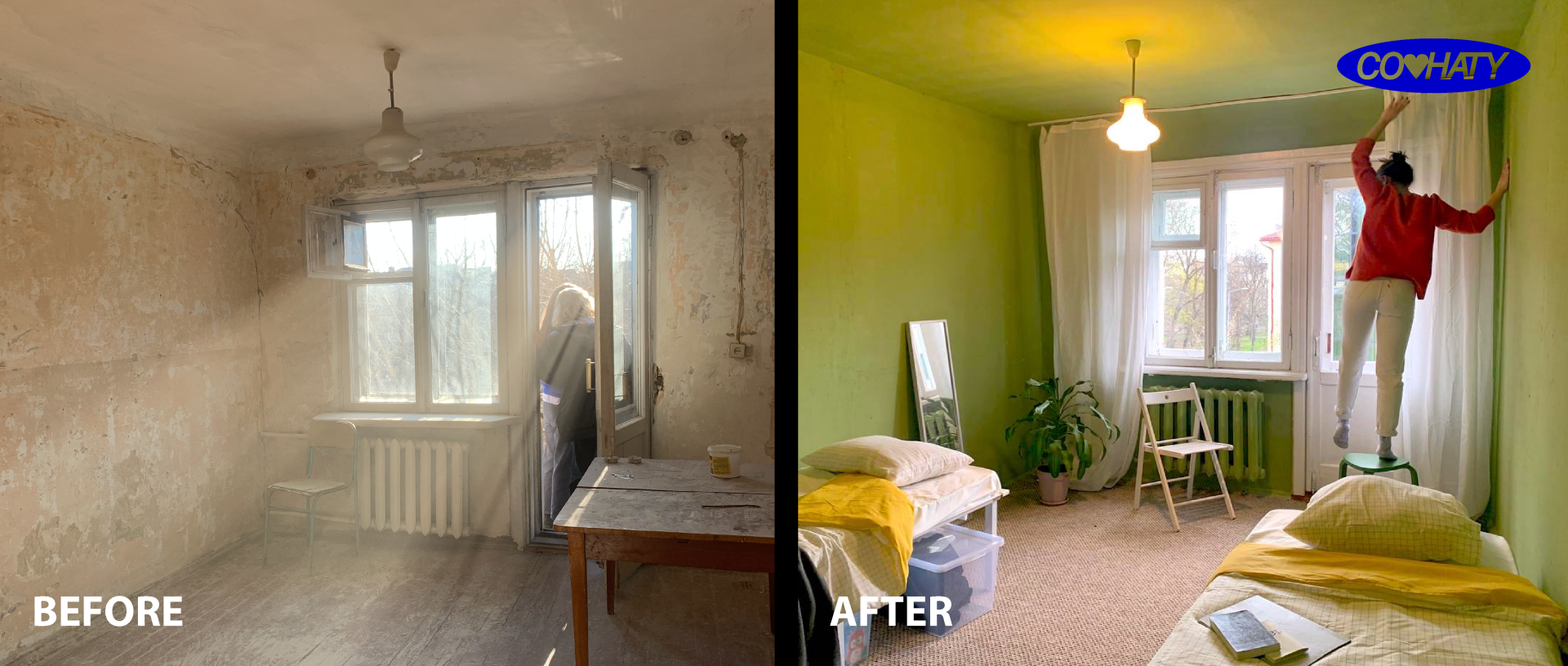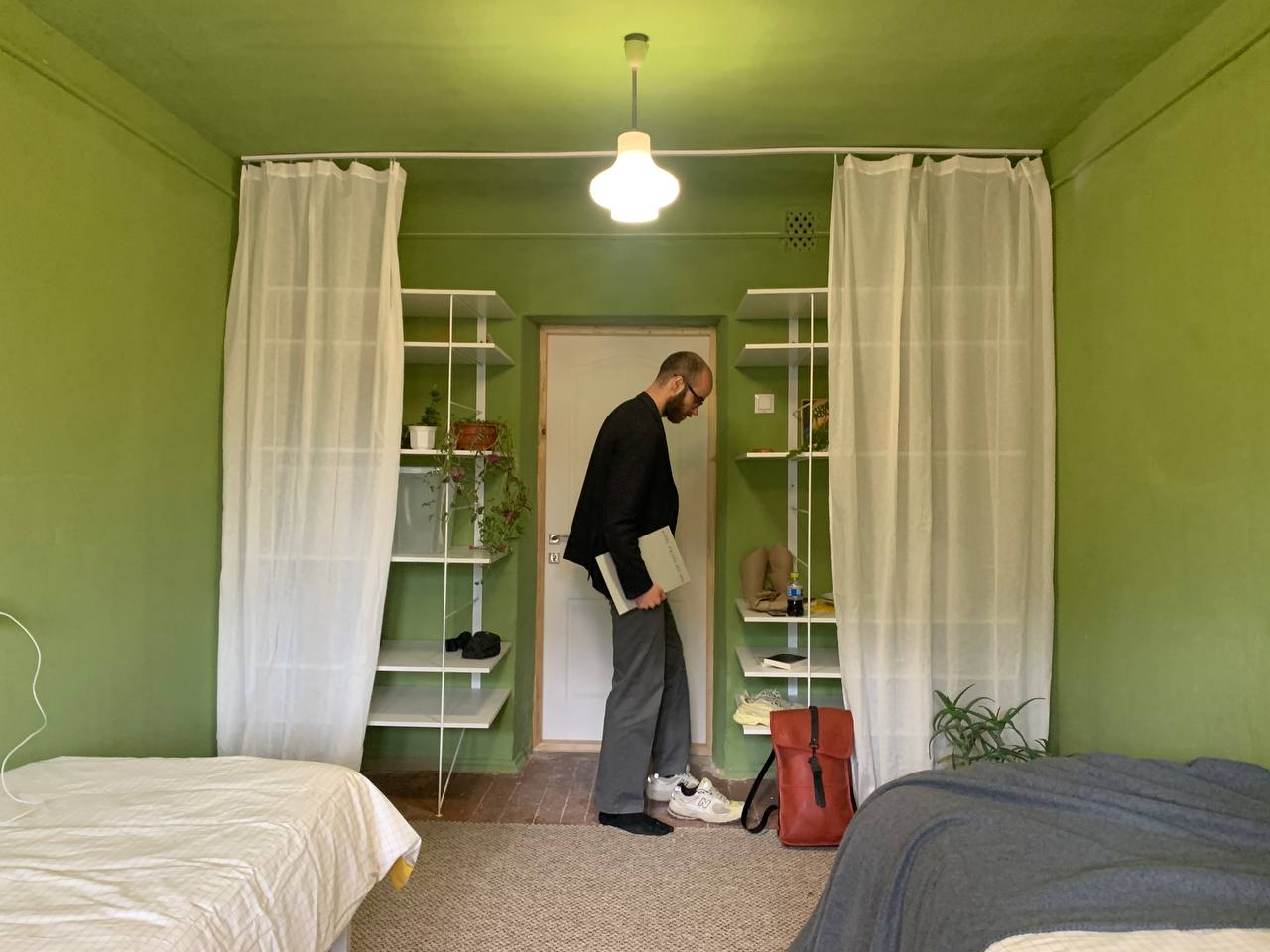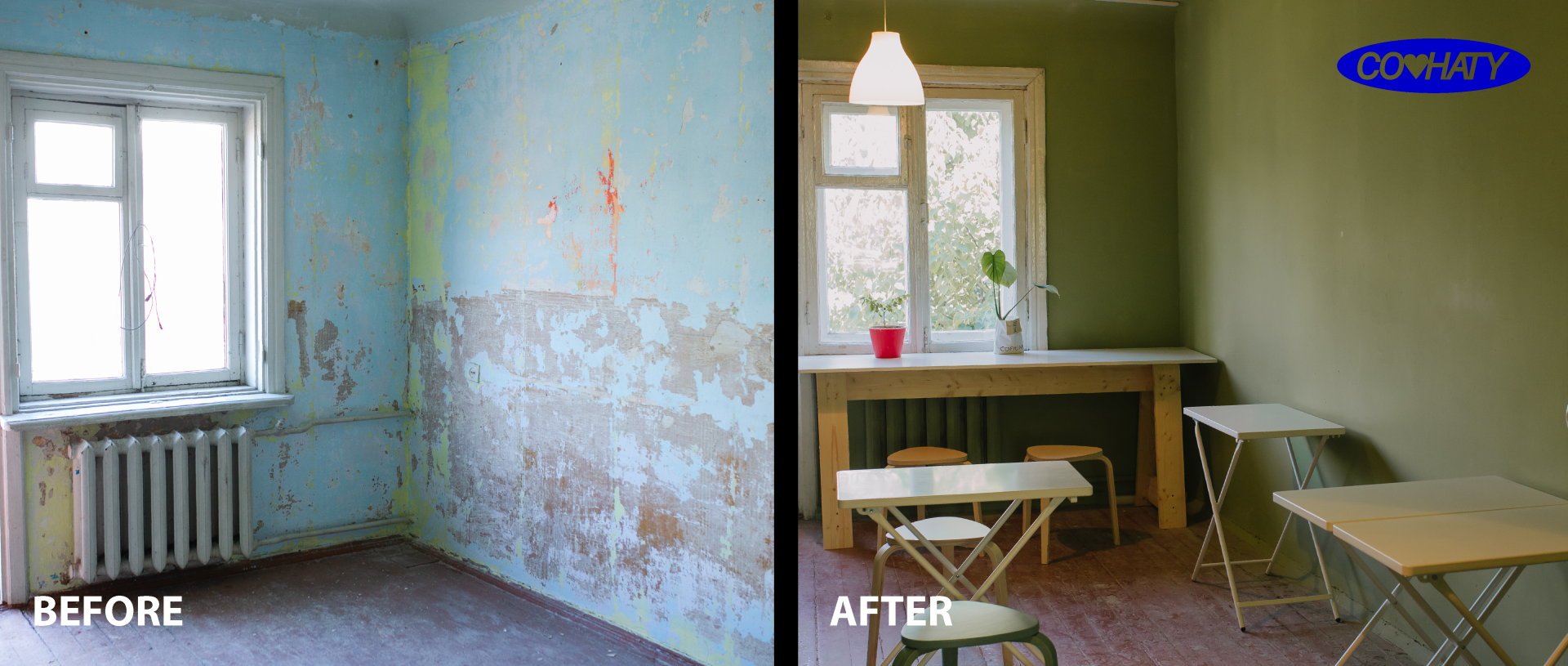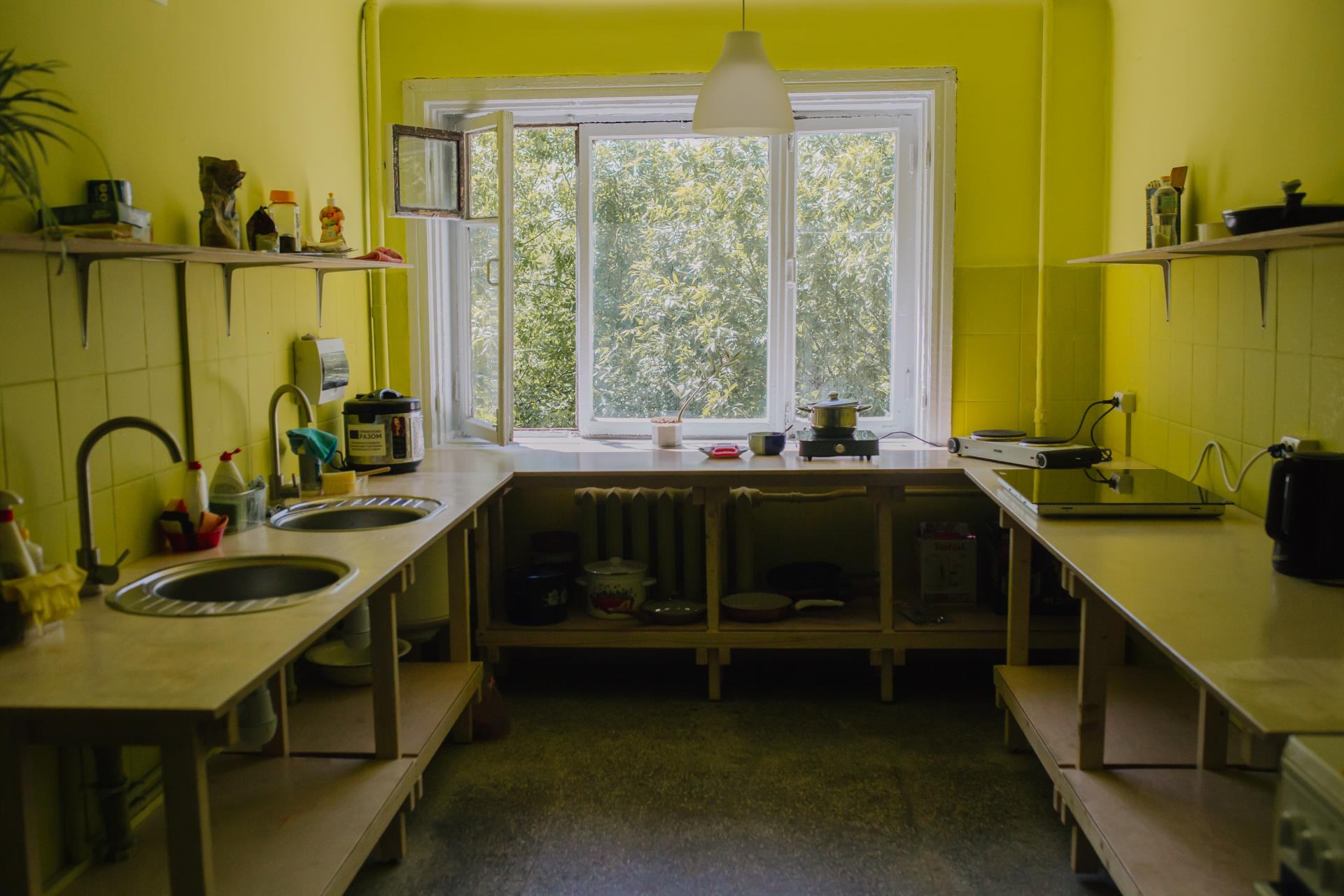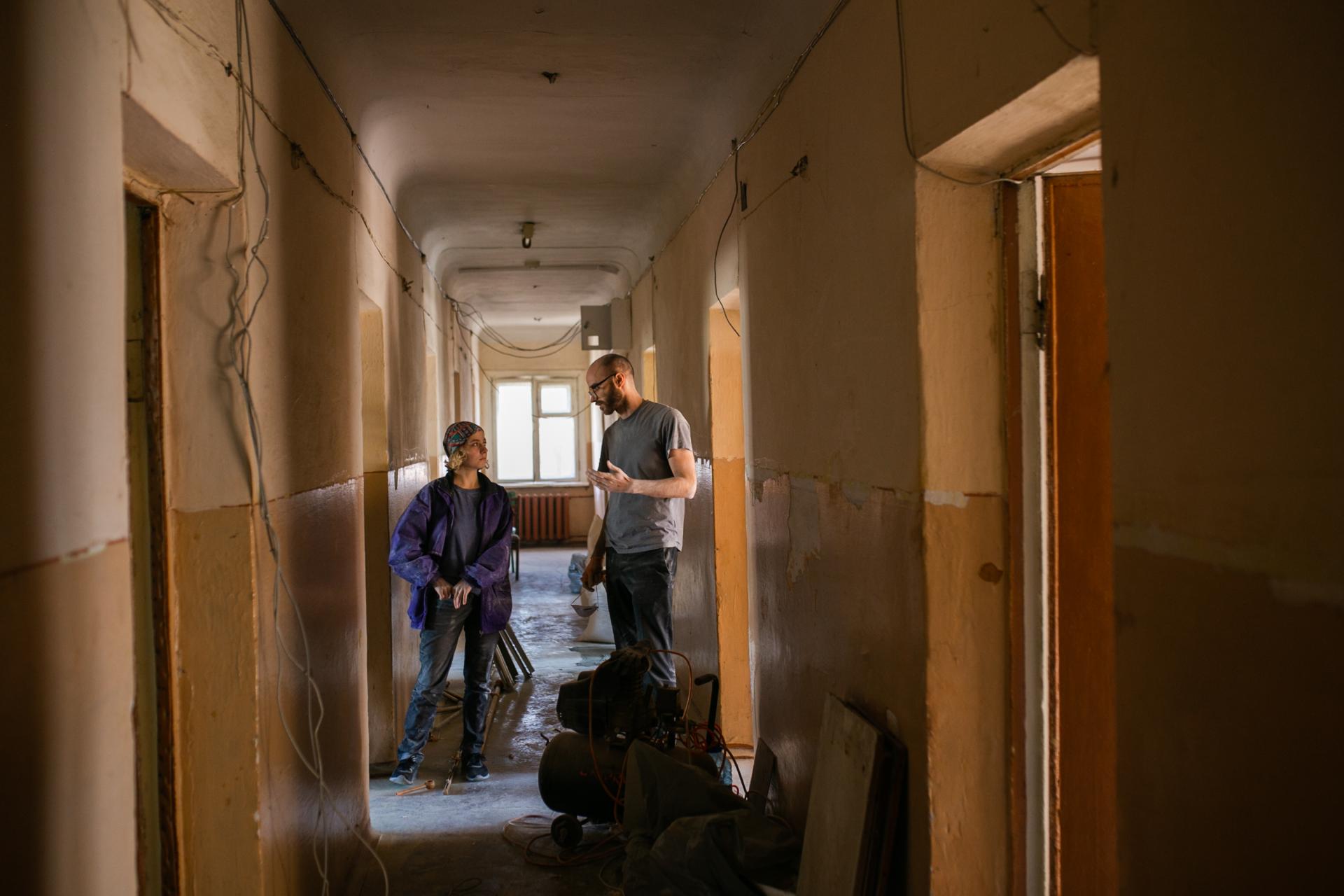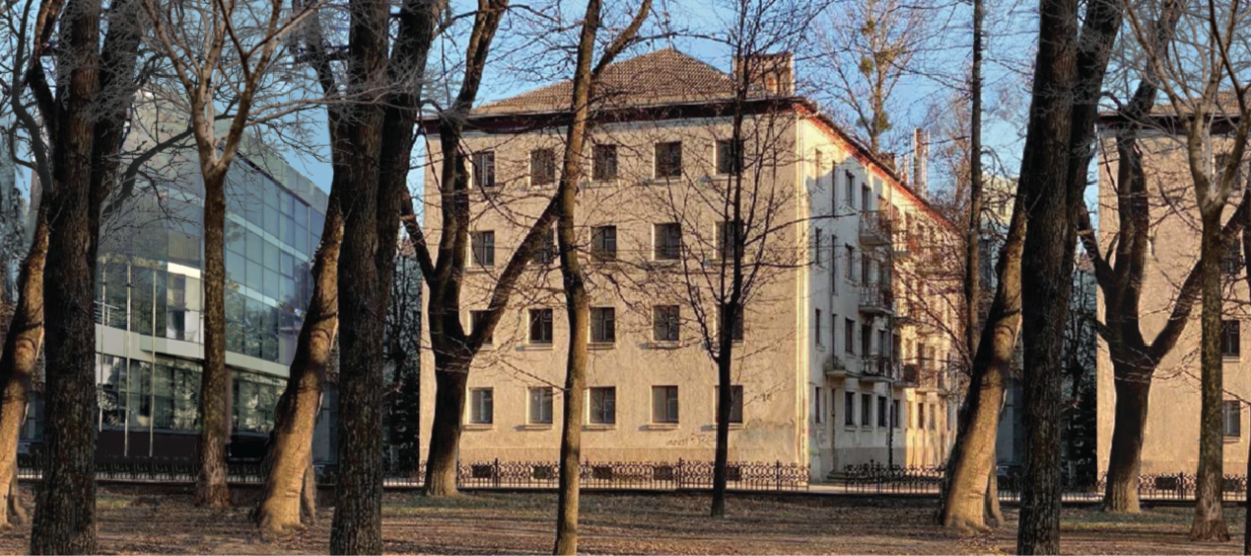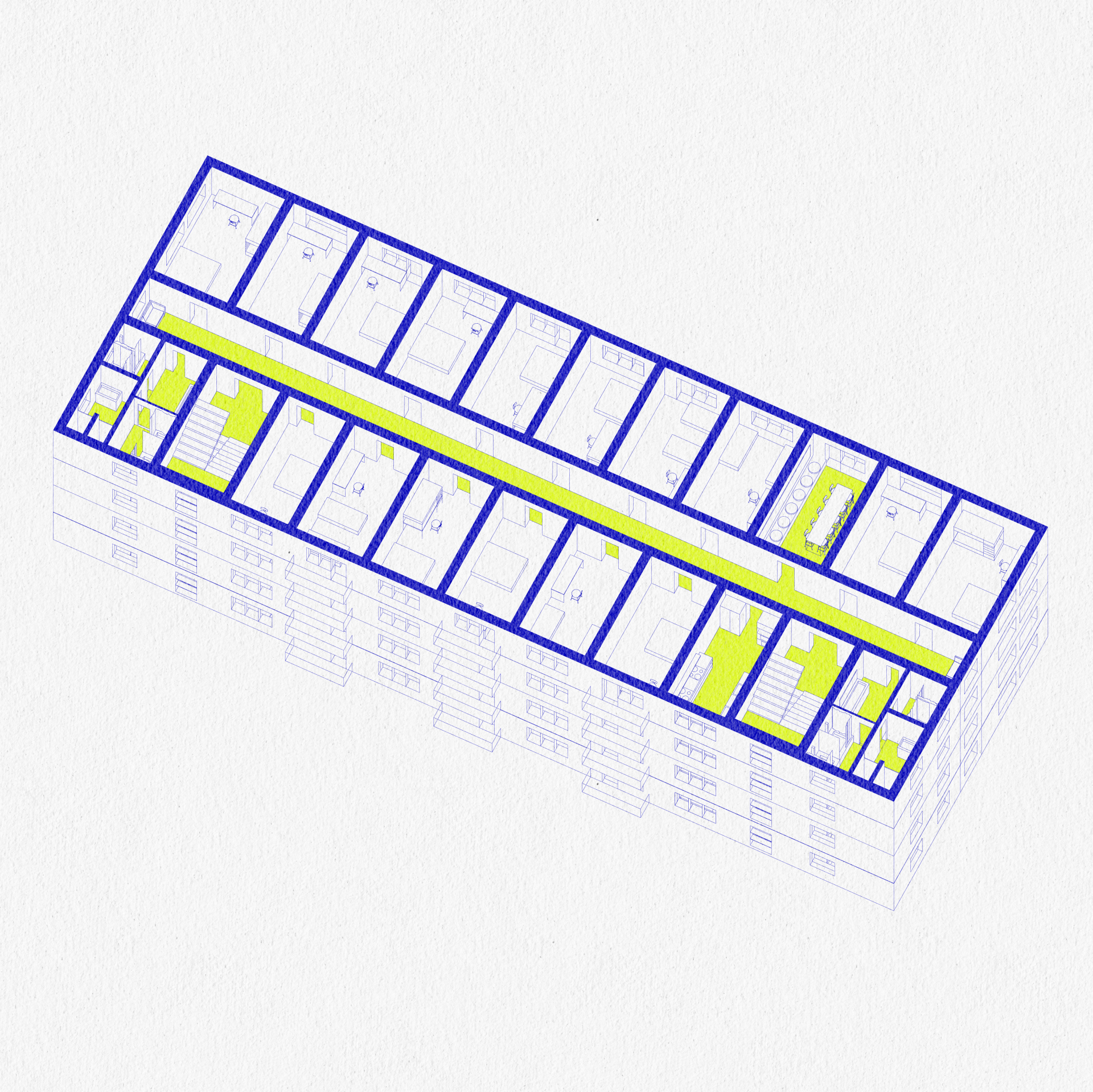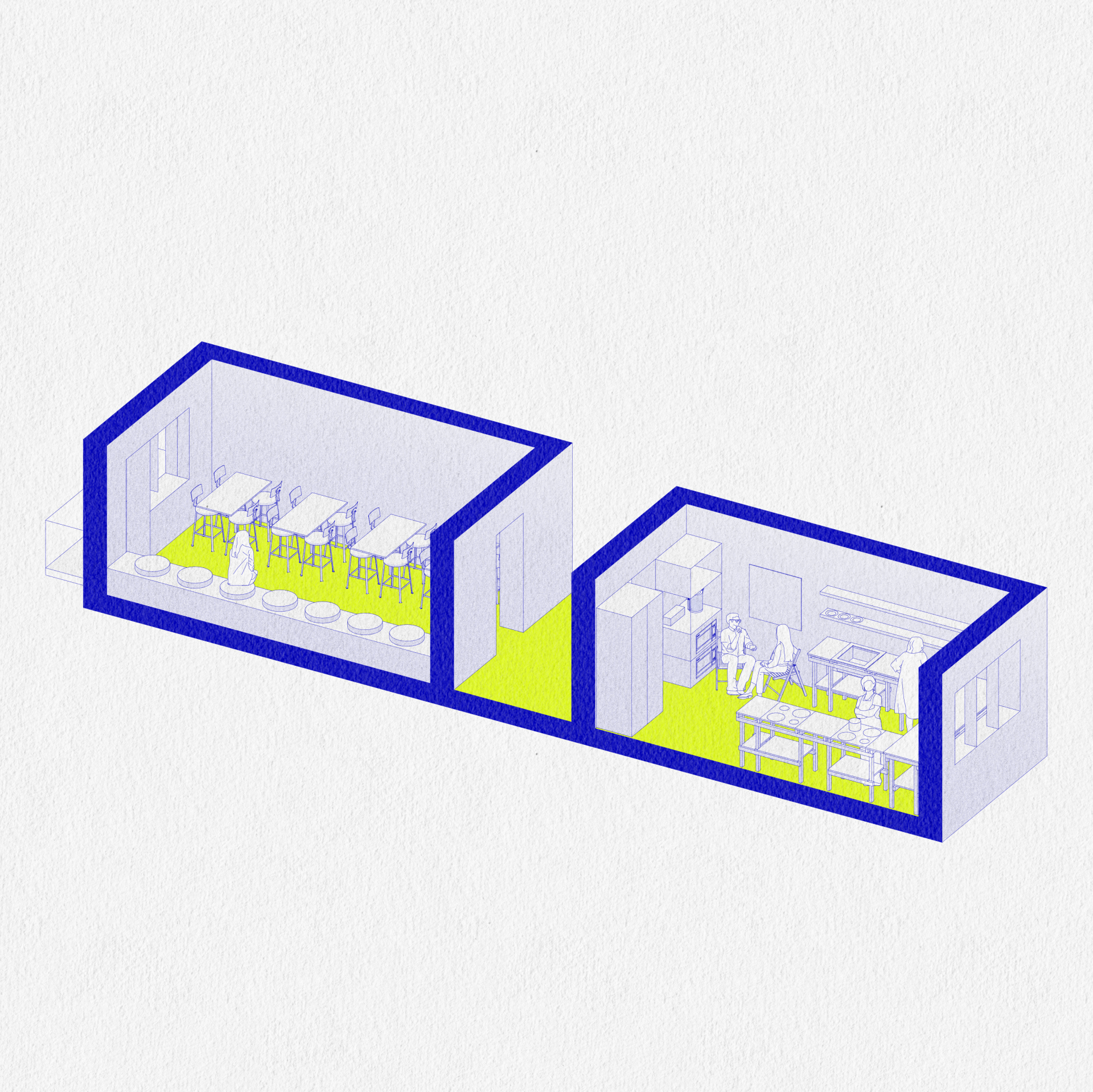CO-HATY
Basic information
Project Title
CO-HATY
Full project title
CO-HATY – аdaptation of a vacant spaces for IDP housing
Category
Prioritising the places and people that need it the most
Project Description
CO-HATY provides emergency temporary accommodation for internally displaced people in Western Ukraine. The Russian invasion of Ukraine forced around 12 million Ukrainians to leave their homes and 6.5 million people moved to the western part of the country. CO-HATY works with local governments and a large network of agencies to repair and retrofit large empty post-soviet municipal buildings into emergency accommodation. It has housed 1330 people in 7 buildings since March 2022.
Geographical Scope
Regional
Project Region
Ivano-Frankivsk, Khmelnytskyi regions, Ukraine
Urban or rural issues
Mainly urban
Physical or other transformations
It refers to a physical transformation of the built environment (hard investment)
EU Programme or fund
Yes
Which funds
Other
Other Funds
German Federal Foreign Office in partnership with humanitarian organization Sign of Hope. <br />
International Organization for Migration (IOM)<br />
IM Swedish Development Partner<br />
Danish Refugee Council
Description of the project
Summary
After the full-scale invasion, the Ivano-Frankivsk region hosted a significant number of IDPs who fled the war and sought refuge. As of July 2022, 140,409 internally displaced persons (97,213 families) were registered in the region, and 40,000 in Ivano-Frankivsk. Among the IDPs registered in the region, 49% are employable (4% are in need of employment), 3% are people with disabilities, 13% are pensioners, and 33% are children. Local authorities, international organizations and volunteer communities are helping to find affordable housing for IDPs, while a significant number of people continue to live in temporary shelters. People of working age have the opportunity to rent housing, but there are also those who cannot afford it.
From March 2022 till October 2023, the METALAB team together with partners have refurbished 7 housing projects in western part of Ukraine, and given temporary housing for around 1300 people. The project is called "CO-HATY"
(HATY) – in Ukrainian, "HOUSES"
(COHATY) – in Ukrainian, “TO LOVE”
CO-HATY is a co-housing project for people who lost their homes due to war.
The goal of the CO-HATY project is not only to provide a roof over their heads, but also to "return decent living conditions."
Here are the 4 first collective centers within the project CO-HATY:
1) The Pilot project “Dormitory” of CO-HATY opened its doors for 170 residents in May 2022 https://www.metalab.space/copy-of-pilot-project.
2) The second collective center in a former kindergarten was completed and opened for 140 residents in December 2022 https://www.metalab.space/copy-of-proj-sadok
3) The third collective center in former Hotel for 80 IDPs was finished in March 2023 https://www.metalab.space/copy-of-proj-hotel
4) The fourth collective center in former Dormitory in Kamyanets-Podilski for 250 IDPs has just been completed, in April 2023 https://www.metalab.space/copy-of-proj-dormitory-zinkivtsi
The project is ongoing
From March 2022 till October 2023, the METALAB team together with partners have refurbished 7 housing projects in western part of Ukraine, and given temporary housing for around 1300 people. The project is called "CO-HATY"
(HATY) – in Ukrainian, "HOUSES"
(COHATY) – in Ukrainian, “TO LOVE”
CO-HATY is a co-housing project for people who lost their homes due to war.
The goal of the CO-HATY project is not only to provide a roof over their heads, but also to "return decent living conditions."
Here are the 4 first collective centers within the project CO-HATY:
1) The Pilot project “Dormitory” of CO-HATY opened its doors for 170 residents in May 2022 https://www.metalab.space/copy-of-pilot-project.
2) The second collective center in a former kindergarten was completed and opened for 140 residents in December 2022 https://www.metalab.space/copy-of-proj-sadok
3) The third collective center in former Hotel for 80 IDPs was finished in March 2023 https://www.metalab.space/copy-of-proj-hotel
4) The fourth collective center in former Dormitory in Kamyanets-Podilski for 250 IDPs has just been completed, in April 2023 https://www.metalab.space/copy-of-proj-dormitory-zinkivtsi
The project is ongoing
Key objectives for sustainability
Emergency Response: The project swiftly provides temporary housing for those fleeing the conflict in Eastern Ukraine. This rapid response, coupled with community input and well-designed accommodations, aligns with the NEB principle of addressing urgent societal needs.
Community Participation: Empowering individuals who have experienced trauma is pivotal. By involving them in the process and offering housing that fosters dignity, the project embraces the NEB ethos of inclusivity and empowerment.
Restoration and Renovation: Opting to repurpose existing structures instead of constructing new housing demonstrates a commitment to sustainability and environmental responsibility, mirroring NEB principles that value resourcefulness and ecological awareness.
Design with Care and Comfort: By deeply understanding the needs and experiences of the internally displaced individuals, the CO-HATY team has tailored the temporary residences to provide comfort and support, embodying the NEB approach of creating humane, user-centered designs.
Social Housing Policies: The project's potential to serve as a model for post-conflict municipal social housing aligns with the NEBgoal of exploring innovative, socially oriented design solutions.
Through its multifaceted approach focusing on rapid response, community empowerment, sustainability, user-centric design, and social impact, this project stands as an exemplar of the New European Bauhaus values. It showcases a holistic, sustainable, and socially conscious way of addressing the immediate and long-term housing needs of internally displaced individuals while fostering dignity, environmental responsibility, and community engagement.
Community Participation: Empowering individuals who have experienced trauma is pivotal. By involving them in the process and offering housing that fosters dignity, the project embraces the NEB ethos of inclusivity and empowerment.
Restoration and Renovation: Opting to repurpose existing structures instead of constructing new housing demonstrates a commitment to sustainability and environmental responsibility, mirroring NEB principles that value resourcefulness and ecological awareness.
Design with Care and Comfort: By deeply understanding the needs and experiences of the internally displaced individuals, the CO-HATY team has tailored the temporary residences to provide comfort and support, embodying the NEB approach of creating humane, user-centered designs.
Social Housing Policies: The project's potential to serve as a model for post-conflict municipal social housing aligns with the NEBgoal of exploring innovative, socially oriented design solutions.
Through its multifaceted approach focusing on rapid response, community empowerment, sustainability, user-centric design, and social impact, this project stands as an exemplar of the New European Bauhaus values. It showcases a holistic, sustainable, and socially conscious way of addressing the immediate and long-term housing needs of internally displaced individuals while fostering dignity, environmental responsibility, and community engagement.
Key objectives for aesthetics and quality
The CO-HATY project places a strong emphasis on aesthetics and the quality of experience for people through design and cultural benefits, with the following key objectives:
Strategic Location for better integration: CO-HATY collective centers are intentionally situated in urban environments close to city facilities, amenities, parks, and green spaces. This thoughtful selection aims to provide a quality living experience that enhances access to essential services and natural surroundings.
Inclusive Design: The project prioritizes inclusivity and access for all residents, including those with disabilities. This is exemplified by the provision of inclusive access and dedicated rooms for people with disabilities on the first floors of CO-HATY buildings. This approach aligns with the project's commitment to ensuring that the housing experience is welcoming and supportive for everyone.
User-Centric Approach: To create a positive quality of experience, the CO-HATY team conducted extensive research by observing life in shelters and interviewing internally displaced people. This in-depth understanding of their experiences and needs has been instrumental in adapting the space to be multifunctional and designing furniture tailored to the temporary residences. The user-centric approach fosters a sense of comfort and well-being.
Exemplary Design: One remarkable example of the project's commitment to quality design is the CO-HATY Bed. This bed, designed with a multifunctional approach, easy assembling, and transportation, offers storage solutions and accessibility features. Its sustainable production aligns with the cultural value of environmental responsibility, while the double bed option provides flexibility for residents. (https://www.metalab.space/copy-of-co-haty-bed)
The project team realized that to ensure a quality life, it is necessary not only to create affordable but qualitative housing, but also to support the integration of
Strategic Location for better integration: CO-HATY collective centers are intentionally situated in urban environments close to city facilities, amenities, parks, and green spaces. This thoughtful selection aims to provide a quality living experience that enhances access to essential services and natural surroundings.
Inclusive Design: The project prioritizes inclusivity and access for all residents, including those with disabilities. This is exemplified by the provision of inclusive access and dedicated rooms for people with disabilities on the first floors of CO-HATY buildings. This approach aligns with the project's commitment to ensuring that the housing experience is welcoming and supportive for everyone.
User-Centric Approach: To create a positive quality of experience, the CO-HATY team conducted extensive research by observing life in shelters and interviewing internally displaced people. This in-depth understanding of their experiences and needs has been instrumental in adapting the space to be multifunctional and designing furniture tailored to the temporary residences. The user-centric approach fosters a sense of comfort and well-being.
Exemplary Design: One remarkable example of the project's commitment to quality design is the CO-HATY Bed. This bed, designed with a multifunctional approach, easy assembling, and transportation, offers storage solutions and accessibility features. Its sustainable production aligns with the cultural value of environmental responsibility, while the double bed option provides flexibility for residents. (https://www.metalab.space/copy-of-co-haty-bed)
The project team realized that to ensure a quality life, it is necessary not only to create affordable but qualitative housing, but also to support the integration of
Key objectives for inclusion
An important component of CO-HATY is the involvement of (future) residents in the planning, repair, and administration of the living spaces. One example is the design of a courtyard near one of the buildings. We held a workshop with the residents where they described the desired space of the courtyard. A little later, the workshop participants joined in cleaning the yard, clearing the garden and trimming the bushes, taking agency and ownership of their new space.
The project prioritizes inclusivity and access for all residents, including those with disabilities. We try to implement as many inclusive solutions as we can within the space and resources limitations. This is exemplified by the provision of inclusive access and dedicated rooms for people with disabilities on the first floors of CO-HATY buildings.
For social integration we encourage IDPs and the local community to help us build future accommodation. Five volunteers already became a part of the CO-HATY team. They have been sharing our responsibility.
For economic integration we work with local productions. For our pilot project we ordered 70 beds designed by CO-HATY designers in cooperation with the local production team. Recently, we ordered 500 more pieces of modular furniture to equip the rooms in another project and we continue to provide local companies with work.
A team of Ukrainian experts in housing, urban research, and sustainable development, we seek to analyze the current housing crisis in Ukraine and develop housing policies that will build up the path forward towards systemic change.
The project prioritizes inclusivity and access for all residents, including those with disabilities. We try to implement as many inclusive solutions as we can within the space and resources limitations. This is exemplified by the provision of inclusive access and dedicated rooms for people with disabilities on the first floors of CO-HATY buildings.
For social integration we encourage IDPs and the local community to help us build future accommodation. Five volunteers already became a part of the CO-HATY team. They have been sharing our responsibility.
For economic integration we work with local productions. For our pilot project we ordered 70 beds designed by CO-HATY designers in cooperation with the local production team. Recently, we ordered 500 more pieces of modular furniture to equip the rooms in another project and we continue to provide local companies with work.
A team of Ukrainian experts in housing, urban research, and sustainable development, we seek to analyze the current housing crisis in Ukraine and develop housing policies that will build up the path forward towards systemic change.
Results in relation to category
The CO-HATY project has made significant strides in various domains:
Spatial Impact:
- Urban Integration: Successfully integrating new settlements into urban areas by adaptively using abandoned spaces for new functions.
- Resource Reuse: Utilizing abandoned buildings reduces embodied energy, making efficient use of existing materials and spaces.
- Comfortable Living Conditions: Design focus ensures care and comfort, providing dignified living conditions for vulnerable individuals.
Financial Impact:
- Diverse Funding and Economic Reintegration: Mobilized varied funding sources, restoring emergency housing. Employing displaced individuals aids their economic reintegration. Contracted IDPs have become shelter managers and gained new qualifications.
- Support for Local Businesses: Production collaborations with local teams benefit the economy, creating beds and modular furniture.
Social Impact:
- Community-Centric Housing: Housing over 1330 people in a collective model creates a sense of community in individual units and communal spaces.
- Empowerment and Integration: Involving displaced individuals in the design process cultivates creativity, empowerment, and a sense of community.
- Skill Utilization and Employment: Volunteers contribute skills in construction and management, with several becoming staff members, fostering professional growth and integration.
Environmental Impact:
- Energy Conservation: Repairing abandoned buildings significantly reduces embodied energy, showcasing commitment to sustainability.
- Resourceful Furnishing: Furnishing with donated second-hand items and locally sourcing materials reduces waste and minimizes the carbon footprint, highlighting environmental responsibility.
- These achievements demonstrate a comprehensive approach that addresses immediate housing needs while prioritizing sustainability, community integration, and empowerment for displaced populations.
Spatial Impact:
- Urban Integration: Successfully integrating new settlements into urban areas by adaptively using abandoned spaces for new functions.
- Resource Reuse: Utilizing abandoned buildings reduces embodied energy, making efficient use of existing materials and spaces.
- Comfortable Living Conditions: Design focus ensures care and comfort, providing dignified living conditions for vulnerable individuals.
Financial Impact:
- Diverse Funding and Economic Reintegration: Mobilized varied funding sources, restoring emergency housing. Employing displaced individuals aids their economic reintegration. Contracted IDPs have become shelter managers and gained new qualifications.
- Support for Local Businesses: Production collaborations with local teams benefit the economy, creating beds and modular furniture.
Social Impact:
- Community-Centric Housing: Housing over 1330 people in a collective model creates a sense of community in individual units and communal spaces.
- Empowerment and Integration: Involving displaced individuals in the design process cultivates creativity, empowerment, and a sense of community.
- Skill Utilization and Employment: Volunteers contribute skills in construction and management, with several becoming staff members, fostering professional growth and integration.
Environmental Impact:
- Energy Conservation: Repairing abandoned buildings significantly reduces embodied energy, showcasing commitment to sustainability.
- Resourceful Furnishing: Furnishing with donated second-hand items and locally sourcing materials reduces waste and minimizes the carbon footprint, highlighting environmental responsibility.
- These achievements demonstrate a comprehensive approach that addresses immediate housing needs while prioritizing sustainability, community integration, and empowerment for displaced populations.
How Citizens benefit
The main groups benefiting from CO-HATY are internally displaced people, both residents and volunteers. Regarding residents, this project mobilized quickly to provide emergency accommodation during a housing shortage in the Western part of the country. It also involved residents in the design process to give them some sense of control and empowerment. The housing environment – both in its construction and management – is collective and collaborative, helping residents form a sense of community and solidarity with others. For those who volunteer to help in the construction, it is also empowering to support others affected by the crisis as well as use their professions that many of them lost due to the invasion.
The other groups benefiting from this project include municipal government services, health and social care providers, humanitarian organisations and civil society. This project has effectively coordinated and involved these services through housing provision. Moreover, METALAB helps relieve some of the emergency situation in Western Ukraine currently being experienced by services that are under significant pressure. For example, prior to this project, the regional administration had housed displaced people for six months in temporary accommodation that was only designed for a two week’s stay.
The other groups benefiting from this project include municipal government services, health and social care providers, humanitarian organisations and civil society. This project has effectively coordinated and involved these services through housing provision. Moreover, METALAB helps relieve some of the emergency situation in Western Ukraine currently being experienced by services that are under significant pressure. For example, prior to this project, the regional administration had housed displaced people for six months in temporary accommodation that was only designed for a two week’s stay.
Physical or other transformations
It refers to a physical transformation of the built environment (hard investment)
Innovative character
METALAB is innovative given its ability – particularly as a small urban laboratory - to deliver well-designed, community-informed housing in a country currently undergoing conflict. It sets higher standards through its organizational model, community participation and retrofitting. Despite its size, it has also managed to mobilize many different stakeholders from the civic, public and business sectors, as well as give communities direct input into the design of their respective units.
What makes CO-HATY unique is its more holistic approach and the localisation and partnership of so many different initiatives involved. It emphasizes cross-sectoral integration and works closely with the local government authority, recognising that this is not only vital to housing delivery but that it also has potential to cultivate better housing rights and regulatory change. They factor in potential long-term issues such as minimizing the risks of evictions (if buildings were privately owned) and work to change the housing market narrative in Ukraine, which is heavily focused on privatization.
What makes CO-HATY unique is its more holistic approach and the localisation and partnership of so many different initiatives involved. It emphasizes cross-sectoral integration and works closely with the local government authority, recognising that this is not only vital to housing delivery but that it also has potential to cultivate better housing rights and regulatory change. They factor in potential long-term issues such as minimizing the risks of evictions (if buildings were privately owned) and work to change the housing market narrative in Ukraine, which is heavily focused on privatization.
Disciplines/knowledge reflected
The CO-HATY project engages a multidisciplinary approach where various fields intersect to address the complex challenges of renovating and delivering housing during conflict, thereby offering a holistic and adaptive response. Complexity Management of METALAB in this project includes knowledge of architectural and urban expertise, raising budgets for repairing and furnishing, coordinating partners and the construction process, and designing furniture for retrofitted spaces, providing community development activities and legal support for the residents of CO-HATY.
The added value of this multidisciplinary collaboration lies in its capacity to adapt and respond to unexpected challenges. Through ongoing communication and collaboration, these diverse fields synergize their expertise, enabling the project to navigate complexities and evolving situations effectively. This dynamic interaction allows for innovative problem-solving and ensures a comprehensive approach to housing solutions in times of crisis. The amalgamation of various disciplines not only addresses immediate housing needs but also fosters a supportive and inclusive environment, ensuring the well-being and comfort of the displaced community.
The added value of this multidisciplinary collaboration lies in its capacity to adapt and respond to unexpected challenges. Through ongoing communication and collaboration, these diverse fields synergize their expertise, enabling the project to navigate complexities and evolving situations effectively. This dynamic interaction allows for innovative problem-solving and ensures a comprehensive approach to housing solutions in times of crisis. The amalgamation of various disciplines not only addresses immediate housing needs but also fosters a supportive and inclusive environment, ensuring the well-being and comfort of the displaced community.
Methodology used
An important component of CO-HATY is the involvement of (future) residents in the planning, repair, and administration of the living spaces. Few examples of such activities are: the participatory design workshops for public spaces near or within the building, tolokas (common cleaning of the area), creating public furniture with the residents, gardening activities and so on. For social integration, we encourage IDPs and the local community to help us build future accommodation. Many volunteers have already joined the CO-HATY team and have been sharing our responsibility.
CO-HATY strategy for the next projects is to improve socio-economic inclusion of IDPs in existing CO-HATY centers and upcoming projects as well, based on our experiments and secondary national and world studies. The plan aims to support residents to become a self-managing community.
CO-HATY strategy for the next projects is to improve socio-economic inclusion of IDPs in existing CO-HATY centers and upcoming projects as well, based on our experiments and secondary national and world studies. The plan aims to support residents to become a self-managing community.
How stakeholders are engaged
METALAB has involved a network of partners established over the past eight years, as well as engaged new partners to help them deliver housing at a larger scale. These partners (more than 25 in total) include housing non-profits, legal organisations, design studios, educational and social services, humanitarian organisations, real estate specialists and municipal agencies.
Teams involve their network partners, with whom we worked for the last 8 years. They are Insha Osvita (providing coordination support for shelters and fundraising), New Housing Policy - consultations on organizational models of non-profit housing, Izolyatsia and New Democracy Fund (support in participatory designing common space by one of the buildings), NGO “Critical Thinking” (architectural expertise and organizational assistance for the pilot project), and Everlegal (legal support). Our circle of partners partners includes:
Volunteer initiative “Second Home IF” - partner in implementing the pilot project
Peremebli - adaptive furniture design
TOLOCAR - mobile makerspaces equipped with tools for quick repairs and rebuilding infrastructure
Building Ukraine Together (BUR) - assistance in the construction process
State Educational Institution “Podilskyi Center of Professional Technical Education” - assistance in the construction process
Ivano-Frankivsk Professional Construction Lyceum - assistance in the construction process
“Parasolka” Open Workshop - technical base, space for furniture prototyping
DUG and Hearts for Ukraine - providing humanitarian aid, home appliances, and other household items
Ukrainische Engel - aid with building materials and furniture
Ro3kvit - international professional networking
BRDA (OKNO) - reuse of building materials and equipment
Association of Real Estate Specialists of Ivano-Frankivsk — financial support and property search assistance
Re-Win – Swiss NGO, who helps to provide reclaimed materials
Teams involve their network partners, with whom we worked for the last 8 years. They are Insha Osvita (providing coordination support for shelters and fundraising), New Housing Policy - consultations on organizational models of non-profit housing, Izolyatsia and New Democracy Fund (support in participatory designing common space by one of the buildings), NGO “Critical Thinking” (architectural expertise and organizational assistance for the pilot project), and Everlegal (legal support). Our circle of partners partners includes:
Volunteer initiative “Second Home IF” - partner in implementing the pilot project
Peremebli - adaptive furniture design
TOLOCAR - mobile makerspaces equipped with tools for quick repairs and rebuilding infrastructure
Building Ukraine Together (BUR) - assistance in the construction process
State Educational Institution “Podilskyi Center of Professional Technical Education” - assistance in the construction process
Ivano-Frankivsk Professional Construction Lyceum - assistance in the construction process
“Parasolka” Open Workshop - technical base, space for furniture prototyping
DUG and Hearts for Ukraine - providing humanitarian aid, home appliances, and other household items
Ukrainische Engel - aid with building materials and furniture
Ro3kvit - international professional networking
BRDA (OKNO) - reuse of building materials and equipment
Association of Real Estate Specialists of Ivano-Frankivsk — financial support and property search assistance
Re-Win – Swiss NGO, who helps to provide reclaimed materials
Global challenges
By repairing abandoned buildings we save almost 50% on energy for construction purposes and diminish our potential CO2/carbon footprint. We keep a building envelope, provide minor repairs and fix damage. Furthermore, our production of furniture, often utilizing recycled materials, is all done locally, reducing the carbon footprint of excessive shipping operations. Inhabiting non-housing facilities requires space adjustments. Minimizing the use of new elements due to limited availability, means hunting for more vacant old buildings and free components.
Our sustainable and adaptive approach for the reuse of equipment and materials for housing, sourcing local materials as much as possible, together with the access to our own production facilities at makerspace allowed us to improve our fundraising and establish good partnerships for provision of decent housing conditions for IDPs, many of whom are women with children. While working on the design of public spaces in the housing facilities, we always think of flexible space that can be used for entrepreneurial activities of men and women who will live there and therefore will be able to provide necessary services for the community and earn their livelihood.
Our sustainable and adaptive approach for the reuse of equipment and materials for housing, sourcing local materials as much as possible, together with the access to our own production facilities at makerspace allowed us to improve our fundraising and establish good partnerships for provision of decent housing conditions for IDPs, many of whom are women with children. While working on the design of public spaces in the housing facilities, we always think of flexible space that can be used for entrepreneurial activities of men and women who will live there and therefore will be able to provide necessary services for the community and earn their livelihood.
Learning transferred to other parties
The pilot project, implemented in May 2022, demonstrated its value, prompting further action. Over 1.5 years, we restored six additional buildings, five within the Ivano-Frankivsk region and one near Kamianets-Podilskyi. This ongoing effort aims to provide comfortable housing for internally displaced persons, with an ongoing search for the next buildings to restore. Working predominantly with buildings from the 1960s to 1980s, CO-HATY's spatial transformation approach can be broadly applied to similar abandoned structures.
Throughout 2023, we've continued to receive requests for renovations on existing buildings functioning as shelters, aiming to improve conditions or transform potential new homes. Simultaneously, we're considering the further evolution of the CO-HATY project and scouting opportunities to execute a pilot project for permanent social housing in 2024.
Moreover, in partnership with Ukrainian housing, urban research, and sustainable development experts from the New Housing Policy initiative, we're conducting an analysis of Ukraine's housing crisis to shape forward-thinking housing policies. Our goal is to formulate project concepts for internally displaced persons, acting as a test-ground for innovative policy-making and enhanced stakeholder engagement in housing.
Furthermore, the CO-HATY team offers consultancy in participatory design. In 2022, the team was engaged by the GIZ office in Ukraine to consult the local communities in Zhytomyr and Lviv for the transformation of abandoned buildings in these cities. Our approach to localized production of home furnishings holds potential for replication beyond our current locations.
Throughout 2023, we've continued to receive requests for renovations on existing buildings functioning as shelters, aiming to improve conditions or transform potential new homes. Simultaneously, we're considering the further evolution of the CO-HATY project and scouting opportunities to execute a pilot project for permanent social housing in 2024.
Moreover, in partnership with Ukrainian housing, urban research, and sustainable development experts from the New Housing Policy initiative, we're conducting an analysis of Ukraine's housing crisis to shape forward-thinking housing policies. Our goal is to formulate project concepts for internally displaced persons, acting as a test-ground for innovative policy-making and enhanced stakeholder engagement in housing.
Furthermore, the CO-HATY team offers consultancy in participatory design. In 2022, the team was engaged by the GIZ office in Ukraine to consult the local communities in Zhytomyr and Lviv for the transformation of abandoned buildings in these cities. Our approach to localized production of home furnishings holds potential for replication beyond our current locations.
Keywords
Emergency Response
Restoration and renovation
Design with care and comfort
Partner Mobilization
Integration through participation

